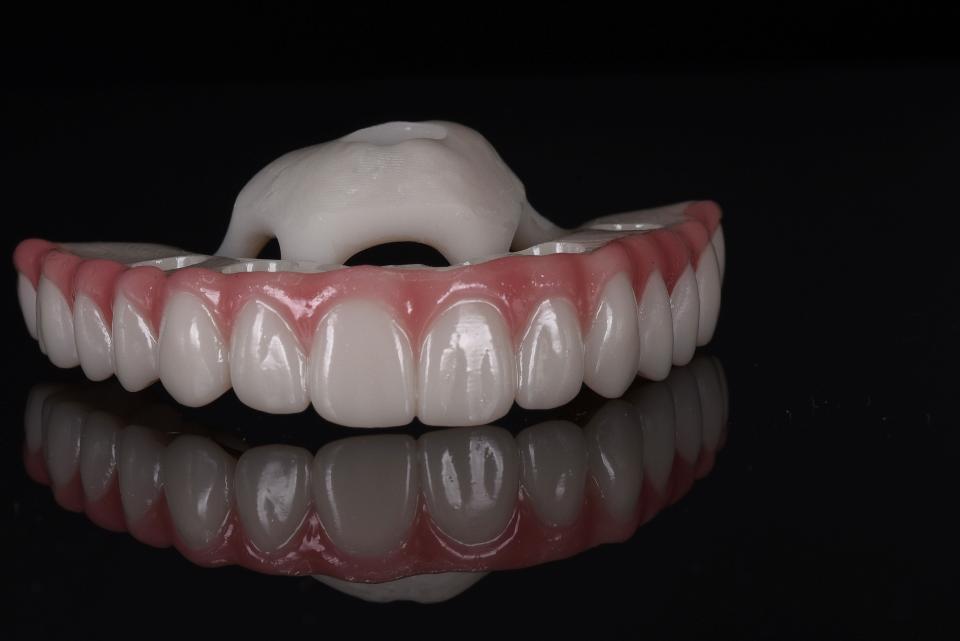
3-D printed dental appliances
The COVID-19 crisis put additive manufacturing (AM, also known as 3-D printing) into the headlines in a big way, as many of those with AM capabilities quickly jumped into producing much-needed but all-too-scarce medical PPE, such as respirators and face shields. But there’s an area of medicine where AM was already having a huge impact on people’s everyday lives before the crisis hit. Dentistry has already been fundamentally changed by AM, and the technology promises even greater innovations to come.
For 3D Systems Corporation

A 3-D printed dental model
“For me personally, it started about 10 or 12 years ago,” said Jacobs, now Business and Market Development Leader for 3D Systems. “I was working with a company selling polymers used to make dentures, and ceramic for crowns. I learned the technology then was time-consuming, expensive, and unpredictable, and it led to mixed quality results. That got me wondering: is there a way to do this faster, more predictably, and more cost-effectively?” That led him first to found NextDent, with its focus on materials, then eventually to his work with 3D Systems on an end-to-end solution.
“We worked with designers and engineers to develop dental 3-D printing,” “We were focused on a complete solution. Our scope now is dentures, crowns and bridges, mid-term orthodontic retainers, and dental models. The puzzle pieces came together, and now we sell a complete solution to the dental market.”
One place where the technology Jacobs helped develop has taken root is in dental labs, which provide materials and services to practicing dentists. “I’m a digital lab,” said Matt Mills, owner of Hybrid Technologies, LLC, a dental lab in Orlando, Florida, that works with clinicians on high-end dental restorations. “I don’t have a product that doesn’t use 3-D printing at some stage.”

Matt Mills
That’s a tremendous step forward. “The old way was to take impressions, pour models in dental stone, add wax, then carve it to the desired end state,” Mills said. The fine-tuned models are then used by dentists to show patients a preview of their treatment, and by ceramists to create the end-use dental devices. “It took eight hours to do a full mouth set. Now we do 3-D scans, do the design within our software, and we’re done in one shot. This digital ‘wax-up’ now takes an hour for design and thirty minutes for printing.”
AM has also moved right into the dental practitioner’s office. Dr. Michael Scherer is a prosthodontist in Sonora, California. He’s a clinician on the forefront, treating patients who need extensive treatments like full-mouth reconstructions. He’s been in practice for 15 years, so he’s seen both the legacy technologies and what AM brings to the table. “I don’t practice in a big city,” he said. “I’m in a town of 10,000, with a lot of retirees. Some of my older patients travel three or four hours to come to the office.”
For dentures, bridgework or implants, multiple visits are required. Dr. Scherer looked to AM to help alleviate that burden. It quickly showed its value. “I got to a point where I can no longer imagine doing without a 3-D printer,” he said. “Now we can scan the patient and download the scan into our software. Then we use it to prep for surgery and to create models for the dental devices. I can print an exact prototype, and do temporaries to put in the mouth while a technician converts the model to porcelain. It cut five visits down to two or three.”
That time savings is a huge benefit to many of his patients. There are others as well. “It’s more precise and delivers a better outcome,” said Dr. Scherer. “But the biggest benefit is the patient ‘wow factor.’” It’s one way I distinguish myself from an ordinary dentist.” Other benefits are the ability to quickly scan and make a carbon copy of an existing denture, and to readily improve a device that feels wrong.

Dr. Michael Scherer
Those current benefits are only just scratching the surface, though. “Within 20 years we’ll be printing ceramics,” said Mills. “That’ll be the end game for dental – printing the final-state devices. Current ways of making those are labor- and time-consuming. Don’t get me wrong–ceramists are the stars of our business. They’re a hot commodity right now. But once ceramic printing is affordable, 3-D printing will be bigger than milling ever was. The materials are so much more flexible. Printing hasn’t seen its heyday–we’re currently printing plastics–temporaries and models. When we can print the definitive restoration, that will be big.”
Dr. Scherer agrees. “We’re just on the tipping point of what we can do,” he said. “There are 60 million dentures in the U.S., and that number’s not decreasing–it’s still accelerating. AM will make them better, faster and cheaper–it’ll be a huge improvement on people’s lives.”
“In five or ten years, we’ll have a 3-D printer in dentists’ offices everywhere,” added Jacobs. “And not just in the developed world–for the developing world, this can short-cut them to the most modern solutions. Asia is already massively adopting 3-D printing. I foresee a time in the not-too-distant future where everyone will follow.”
